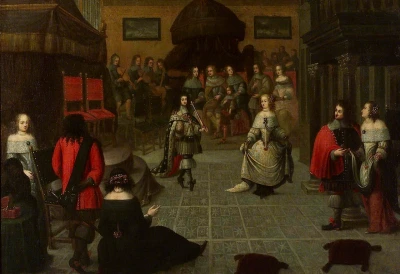Samuel Pepys provides us with two descriptions of balls at the Restoration court that deserve to be better known.
The first took place on 31 December 1662. After seeing the Duke and Duchess of York at supper, Pepys went ‘into the room where the Ball was to be, crammed with fine ladies, the greatest of the Court’, all waiting for the ball to begin.
‘By and by comes the King and Queen, the Duke and Duchesse, and all the great ones; and after seating themselfs, the King takes out the Duchess of Yorke, and the Duke the Duchesse of Buckingham, the Duke of Monmouth my Lady Castlemayne, and so other lords other ladies; and they danced the Bransle. After that the King led a Lady a single Coranto; and then the rest of the Lords, one after the other, other ladies. Very noble it was, and a great pleasure to see. Then to Country dances; the King leading the first which he called for; which was – says he, Cuckolds all a-row, the old dance of England. … The manner was, when the King dances, all the ladies in the room, and the Queen herself, stands up; and endeed he dances rarely and much better then the Duke of Yorke.’
Pepys enjoyed the occasion. ‘Having stayed here as long as I thought fit, to my infinite content, it being the greatest pleasure I could wish now to see at Court, I went out, leaving them dancing.’
On 15 November 1666, Pepys wrote of ‘the Ball at night at Court, it being the Queenes Birthday’. He took himself along to Whitehall Palace to watch the event.
‘Anon the house grew full, and the candles lit, and the King and Queen and all the ladies set. And it was endeed a glorious sight to see Mrs. Steward in black and white lace – and her head and shoulders dressed with Dyamonds. And the like a great many great ladies more (only, the Queene none); and the King in his rich vest of some rich silk and silver trimming, as the Duke of York and all the dancers were, some of cloth of silver, and others of other sorts, exceeding rich. Presently after the King was come in, he tooke the Queene, and about fourteen more couple there was, and begun the Bransles.’
Pepys tried to recall all the dancers, but could remember only some of them, ‘But all most excellently dressed, in rich petticoats and gowns and Dyamonds – and pearl.’ He then turned back to the dancing.
‘After the Bransles, then to a Corant, and now and then a French Dance; but that so rare that the Corants grew tiresome, that I wished it done. Only, Mrs. Steward danced mighty finely, and many French dances, especially one the King called the New Dance, which was very pretty. But upon the whole matter the business of the dancing itself was not extraordinarily pleasing. But the clothes and sight of the persons was indeed very pleasing, and worth my coming, being never likely to see more gallantry while I live – if I should come twenty times.’
Pepys does not say what time the ball began, but ‘About 12 at night it broke up’. He had mixed feelings about it ‘between displeased at the dull dancing, and satisfied at the clothes and persons.’
Pepys is not the most reliable narrator when it comes to dancing. His attention was constantly drawn to the women, particularly the countess of Castlemaine, and it is doubtful that he knew much about dance steps and figures. Nevertheless, he provides us with valuable information about the sequence of dances at court balls. These began with branles, led by the King, followed by a series of courantes (also initiated by the monarch) which might be interspersed with ‘French Dances’ before the country dances with which the ball ended. The ‘French Dances’ were perhaps choreographed duets – earlier versions of the ballroom dances published in notation in the early 1700s – whereas the country dances may well have been regarded as distinctly English.
The order, with its emphasis on precedence according to rank, is very similar to that outlined by Pierre Rameau in chapter 16 of Le Maître a danser, published in 1725. Charles II was the son of a French princess, Henrietta Maria, and had spent part of his exile in Paris, so he must have been well aware of the protocol governing the court balls of Louis XIV. There was also a French dancing master at the Restoration court, Jerome Francis Gahory, who must surely have been involved in organising these balls and perhaps creating choreographed dances for them, as his successors Mr Isaac and Anthony L’Abbé certainly did.

Gonzales Coques, Charles II dancing at the Hague, May 1660? (Identification of the dancers is uncertain, but their deportment is very similar to other versions in which Charles II is recognisable)
It seems that there was a long tradition behind the grand balls at the early 18th-century French court, which was shared by the English court. Although Charles II rarely celebrated his birthday with a ball, those for his Queen became almost annual occasions. Such birthday balls would continue from the Restoration well into the 18th century. The bransles disappeared and the courante was replaced by the minuet but, except for these changes, later evidence suggests that the sequence of dances observed by Pepys remained much the same throughout the reigns of William and Mary, Queen Anne and the first three Georges.

What a historical gem, dear Moira! Thank you for this wonderful post. I see that the British describe the Court events dryly without going into details as le Mercure Galant does. By the way, there are articles about Charles II & England in the French Almanach. I could look them through for you. May be I would discover something interesting relative to dancing.
Have a nice week-end!
Best wishes,
Maria